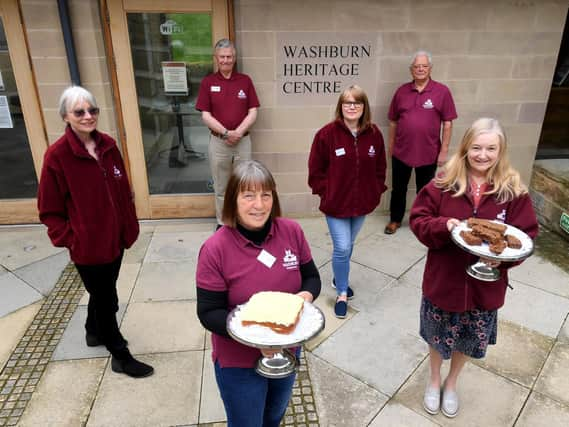Heritage project which uncovered an archeological site of "global significance" celebrates its tenth decade


Since it opened its doors ten years ago, Washburn Heritage Centre, which sits alongside the Grade II listed St Michael and St Lawrence Church in Fewston, has grown into a thriving community hub with a network of volunteers at its core.
But when the idea of creating a new extension was discussed by the Parochial Church Council in 2004, the only facilities at the church was an outside cold water tap.
Advertisement
Hide AdAdvertisement
Hide Ad“We had no proper facilities before the centre was built,” explained Sally Robinson, chair of the Washburn Heritage Management Committee.
“The PCC had the idea to build a small extension to the church which would provide a kitchen, toilet facilities and a small meeting space.”
A project group was put together and a successful grant application made to the National Heritage Lottery Fund in 2008.
The site of the extension would mean disturbing some of the graves at the church which sits on a very ancient site in the Washburn Valley. “Archeologist John Buglass supervised the excavation with a team of volunteers and what they found was astonishing,” Sally said.
Advertisement
Hide AdAdvertisement
Hide AdThe remains of 154 people and a number of artefacts were found during the dig which due to its size, age and location archeologists said was of “global significance”.
“It is very rare for rural churchyards to be excavated and because we had social history records, including contemporaneous diaries from the time people in the assemblage lived, it made it a significant find for archeologists.
“One of the diaries is by John Dickinson known as Timble Man, who lived in Timble village and wrote in his diary every day from the early 1800s to his death around 1911.”
Osteoarcheologists from York and Durham University worked on the Assemblage but only 22 of the 154 people found could be positively identified.
Advertisement
Hide AdAdvertisement
Hide AdA team of volunteers decided to investigate the human stories behind the people in the Fewston Assemblage – known and unknown – which uncovered the life stories of Elizabeth Dibb and George Lister.
Sally, who worked on Elizabeth Dibb’s timeline, said it had been a fascinating project.
Through a grant from the Liz and Terry Bramall Foundation, facial reconstructions of the two former Washburn residents were created by The Facelab at Liverpool John Moores University, the team who worked on the likeness of Richard III.
Sally said everyone involved in the project wanted to remember the 132 individuals in the Assemblage whose names they could not discover.
Advertisement
Hide AdAdvertisement
Hide Ad“A team of stitching volunteers has created a hanging made up of 154 squares. Each square and the thread used are coloured to show age and gender as well as having an individual emblem for each person.”
The Fewston Assemblage was reburied in the churchyard and a Service of Commemoration was attended by nearly 150 people, including more than 40 living descendants of the 22 identified individuals.
A permanent exhibition on the Fewston Assemblage is housed in the lobby at Washburn Heritage Centre and includes the facial reconstructions of George Lister and Elizabeth Dibb.
The original aim of the project was to promote and celebrate the heritage of the Washburn Valley and that has remained a key aspect of the Centre’s work. “To apply for the funding we really had to think about what we wanted the project to be and put together a sustainable business plan which helped us focus on what we were wanting to provide,” Sally said.
Advertisement
Hide AdAdvertisement
Hide AdCreating a Washburn Archive was outlined as one of the ways the project would safeguard the heritage of the valley in its Heritage Lottery Fund application.
But Sally said this had proved much harder to do than first anticipated until they appointed professional archivist Gillian Waters. Gillian worked with a team of eight dedicated volunteers led by Deborah Power to get the archive off the ground and keep it updated.
Now holding around 17,000 items, with just over 9,000 catalogued, the archive is used by a growing number of people from across the globe.
The archive is how volunteer Tom Cox first became involved in the centre.
Advertisement
Hide AdAdvertisement
Hide AdTom, who lives in Harrogate, is a guided walk leader and looks after the centre’s maintenance. Like many of the volunteers he became involved through a family connection to the area.
“From 1939 my parents lived nearby and over the years had bought postcards of the area.
“When I cleared the house out I found several postcards and then we found more at my aunt’s house in London.
“I had heard about the heritage centre and I thought I would hang on to the postcards to see if they would be interested in them.”
Advertisement
Hide AdAdvertisement
Hide AdTom said he was “taken aback” by the centre, which has been described as a “hidden gem”, when he first visited.
Now the postcards are part of the extensive archive, and Tom became part of the growing community of volunteers and members.
Jenny Wilson who is Washburn Heritage Centre’s administrator, said there are currently around 350 members and under normal circumstances would hold a varied events programme open to members and non-members.
“We have a theme and run a series of events including four or five guided walks around the valley which are led by volunteers.
“There are also suppers, which have a wonderful atmosphere, talks and workshops,” Jenny said.